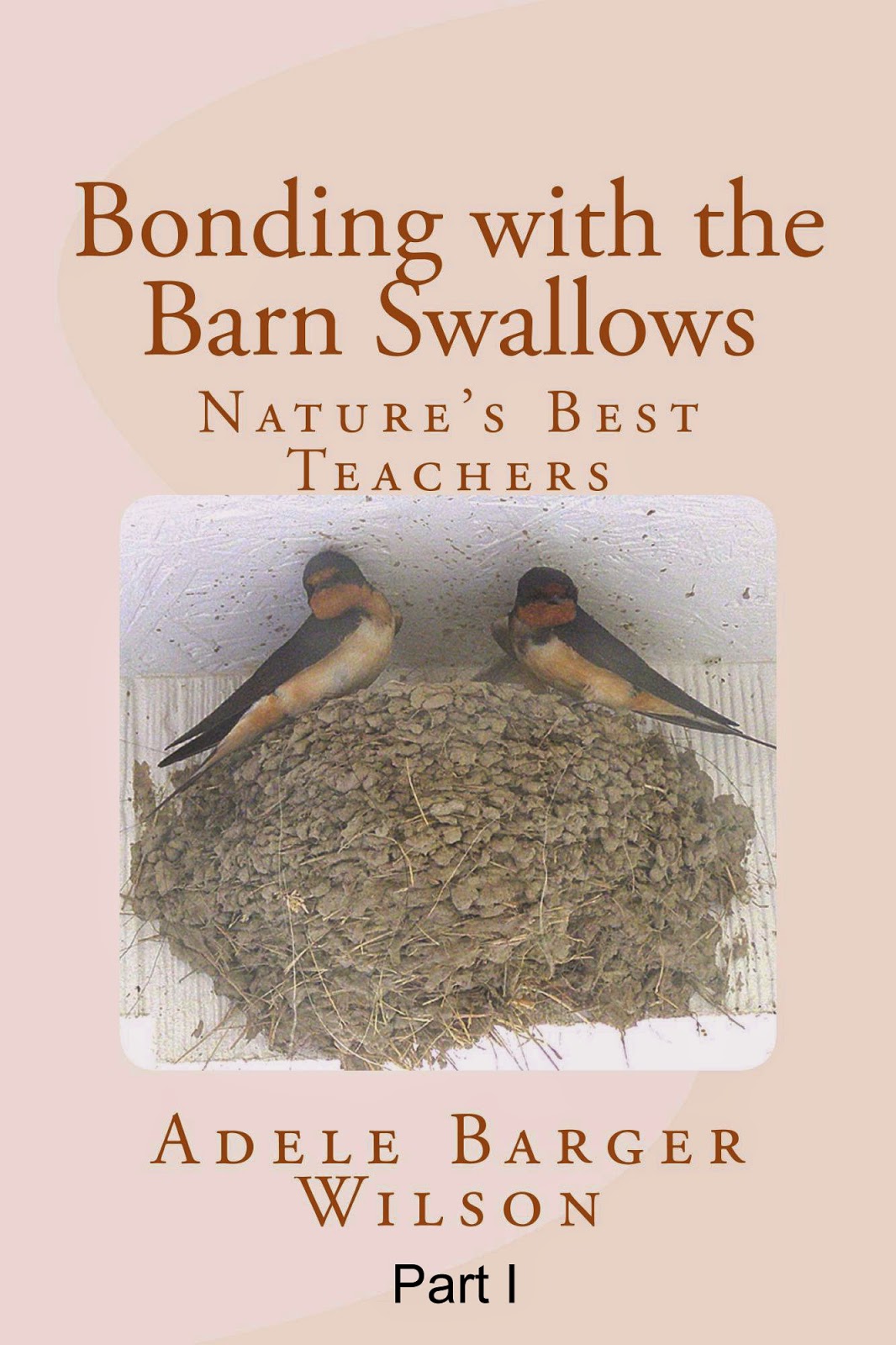by Adele Barger Wilson, author of
Bonding
with the Barn Swallows
Photos and text © 2014 Adele Wilson
Bonding with the Barn Swallows consists of 186 pages and
includes 117 photos. The book is available from Amazon at:
In eastern West Virginia, Barn Swallows return from South America around mid-April.
After recuperating from their long journey north by resting and feasting on flying insects,
the swallows begin their courtship activities.
Once the female chooses a mate, her mate will show her either a previously
used nest or a new nesting site. If the female approves of the location,
the pair will begin to either refurbish the old nest or, if no old nest is
available, to build a nest from scratch.
Once the nest is ready, the pair of swallows begin lining it with
feathers. The feathers ensure both warmth and cushioning for the
soon-to-be-laid eggs.
A female Barn Swallow generally lays three to six eggs, with the average number
being five. She begins incubating her eggs on the day before the last egg
is laid and continues incubating them for about thirteen to fifteen days.
During the incubation time period, the female sits on the nest all
night. The male will guard her by perching near the nest in order to
prevent her from mating with other males.
The male will take turns sitting on the eggs during the daytime so that the
female can forage for flying insects. The female will return to the nest when
she has had her fill, allowing the male to leave the nest and do the
same. Just before sunset, the female will settle into the nest for the night.
The eggs hatch over a period of one to three days. The hatchlings are tiny,
pink, and featherless. The female must continue sitting on the nest for
the first few days in order to keep the hatchlings warm. She will take
only short breaks outside the nest to capture insects on the fly. Both the
female and the male feed the chicks by bringing insects to the nest.
The babies will not be large enough to show their heads above the nest for a
few days. In fact their eyes are still closed during the first week of their lives.
As the babies grow larger, so does the job of feeding them. Feeding the babies is an arduous task that begins just after sunrise and lasts until sunset.
Barn Swallows are very devoted parents. The papa Barn Swallow shares the duty of feeding the nestlings. It
is not unusual for the parent swallows, one at a time, to arrive at the nest with food
every few minutes.
The babies are able to start flapping their
wings on their ninth day of life. From about day twelve they are able to
preen themselves. While their feathers are still growing, the babies display a rather ragged appearance.
By the time a chick is sixteen to seventeen days old, it has acquired much of
its juvenile plumage. Chicks can fledge (leave the nest) at the age of
eighteen days or wait as long as twenty-three days. Nineteen days is the
average fledging age that I have observed.
In the cases of some broods, all of the chicks leave the nest on the same day,
while in other cases, part of the brood will fledge on one day, with the other
part waiting until the next day. Often a fledgling will return to the
nest on the night of the day that it has fledged. It will spend the
night, and then leave the nest for good the following day.
The photo on the right was taken the night before the day that all five of the chicks fledged from the nest. I came home from work that evening to find the nest totally bare.
But later that evening, there was a great surprise. Two of the fledglings returned to the nest and spent the night! Early the next morning, however, the two fledglings left the nest for good. As I was leaving for work that morning, I spotted all five of the fledglings on a fence in a nearby horse pasture, awaiting feeding by their parents.
It has been said that the parents will spend a week feeding the fledglings
outside the nest, but sometimes this time period can be extended. To the left is
a photo of a juvenile, about ten days after leaving the nest. My estimate of its age is about 29 days.
In
Bonding with the Barn Swallows, I share my personal experiences with three broods of Barn Swallows
on my porch through text and photos. The book describes the wonders of seeing them guard the nest area
from the utility wire, the male guarding his mate (from quite unusual positions
on the porch!), marking the nest with a feather, incubating the eggs, feeding
the babies, and even taking breaks to land on the porch rail to let me
photograph them!
Included is the story about how one special male Barn Swallow and I became friends. He even
communicated to me twice, once vocally and the other through his body
language. Two days after he communicated to me by body language, an event revealed what he was trying to tell me.
If you are interested in close-up perspectives of bird behavior or
just want to learn more about birds, this is the book for you!
Just click on the image below to order:

















